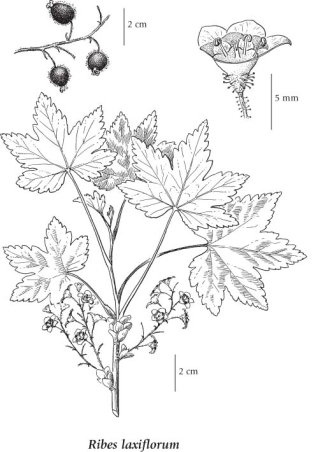Ribes laxiflorum Pursh
trailing black currant
Grossulariaceae (Currant family)
Introduction to Vascular Plants
trailing black currant
Grossulariaceae (Currant family)
Introduction to Vascular Plants
Photograph click to collapse contents
© Dave Ingram (Photo ID #2658)
Photo details
View all photos for this taxon.
Species Information click to expand contents
General:
Deciduous shrub, loosely branched, 0.5-1 (5) m long/tall; stems spreading to decumbent, unarmed, finely crisply short-hairy and with sparse, nearly unstalked glands; bark deep purplish-red.
Leaves:
Alternate, mapleleaf-shaped, deeply heart-shaped at the base, 4-10 cm wide, usually 5-lobed nearly half their length, glabrous on the upper surface, more or less crisply short-hairy and glandular below (at least on the veins), round-toothed; stalks equal to or longer than the blades, glabrous.
Flowers:
Inflorescence of 6-18 flowers in an erect to ascending raceme much shorter than the leaves; flower stalks 0.5-1 mm long, jointed just below the flowers; petals red to purplish, 1-1.5 mm long, broadly kidney- or crescent-shaped; hypanthium shallowly bowl-shaped, about 1 mm long; calyces greenish-white to deep red or purplish, the lobes 2.5-4 mm long, deltoid egg-shaped, hairy on the back and sparsely glandular; styles glabrous, fused to just below or just above the middle, about equaling the stamens.
Fruits:
Berries, egg-shaped, purplish-black, glaucous, 0.6-1 cm long, stalked bristly-glandular.
Illustration click to expand contents

If more than one illustration is available for a species (e.g., separate illustrations were provided for two subspecies) then links to the separate images will be provided below. Note that individual subspecies or varietal illustrations are not always available.
Illustration Source: The Illustrated Flora of British Columbia
Ecology click to expand contents
Ecological Framework for Ribes laxiflorum
The table below shows the species-specific information calculated from
original data (BEC database) provided by the BC Ministry of Forests and Range.
(Updated August, 2013)
The table below shows the species-specific information calculated from
original data (BEC database) provided by the BC Ministry of Forests and Range.
(Updated August, 2013)
| Site Information |
Value / Class |
||
|
Avg |
Min |
Max |
|
| Elevation
(metres) |
786 | 2 | 1969 |
| Slope
Gradient (%) |
18 | 0 | 120 |
|
Aspect (degrees) |
344 | 0 | 360 |
| Soil
Moisture Regime (SMR) [0 - very xeric; 4 - mesic; 8 - hydric] |
4 | 1 | 8 |
| Modal
Nutrient Regime
Class |
D | ||
| #
of field plots species was recorded in: |
625 | ||
| Modal
BEC Zone Class |
SBS | ||
|
All BEC Zones (# of stations/zone) species was recorded in |
BWBS(24), CWH(155), ESSF(142), ICH(52), IDF(1), MH(6), MS(4), SBPS(1), SBS(158), SWB(7) | ||
|
Source:
Klinkenberg 2013
|
|||
Habitat and Range click to expand contents
Moist cliffs, rocky slopes, avalanche tracks, forest margins, forests, and clearings in the lowland and montane zones; common in W and E BC, infrequent in C BC; N to S AK and S YT, E to AB and S to ID and CA.
Status Information click to expand contents
Synonyms click to expand contents
Synonyms and Alternate Names:
Ribes coloradense Coville